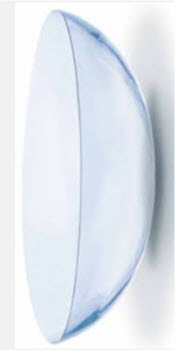The soft contact lens was invented by Otto Wichterle in Czechoslovakia in the 1960s and helped popularize corrective contact lenses as an alternative to eyeglasses. Rigid contact lenses were already available at this time, but they were not very comfortable to use and it would take quite some time for the eye to get use to a rigid lens.
T oday, soft contact lenses (soft CL:s) are very popular. Statistics from the year 2014 show us that of all the contact lens fittings made in the United States that year, 92% were for soft contact lenses. The fairly recently invented silicone hydrogel soft CL was especially sought after and 68% of the fittings were for this type of contact lens. This isn’t very surprising when we consider that the silicone hydrogel soft CL has a very high capacity for letting oxygen pass through the lens and reach the cornea. It is so high that certain silicone hydrogel lenses are approved for use even when the wearer is asleep.
oday, soft contact lenses (soft CL:s) are very popular. Statistics from the year 2014 show us that of all the contact lens fittings made in the United States that year, 92% were for soft contact lenses. The fairly recently invented silicone hydrogel soft CL was especially sought after and 68% of the fittings were for this type of contact lens. This isn’t very surprising when we consider that the silicone hydrogel soft CL has a very high capacity for letting oxygen pass through the lens and reach the cornea. It is so high that certain silicone hydrogel lenses are approved for use even when the wearer is asleep.
The silicone hydrogel soft contact lens was launched in 1998. By adding silicone to the popular hydrogel CLS: of the time, researchers had managed to incorporate silicone’s high gas permeability into the lens. Regrettably, the silicone also made the lens a bit stiffer than the pure hydrogel lens, and the surface could also be more difficult to keep wet. A lot of resources were put into fixing these two issues and that work quickly gave results. Today, new manufacturings techniques for silicone hydrogel CL:s have made them considerably less stiff and more wetable than what they were back in the late 1990s.
I have astigmatism. Can I use soft lenses?
For historical reasons, a lot of people still believe that soft contact lenses are unable to correct for astigmatism. Traditionally, rigid CL:s have be used for astigmatism, but today you can opt for soft lenses instead if you want to.
Soft contact lenses of the type toric is used to correct astigmatism. They are available both in the classic hydrogel material and in the more modern silicone hydrogel material.
Generally speaking, a fitting for soft toric CL:s will be more complex than a fitting for ordinary spherical soft CL:s (the type used to correct myopia or hyperopia). You can also expect to pay more for toric CL:s than for spherical CL:s.
Two important aspects of toric soft CL:s
Unlike spherical soft contact lenses (the type used to correct myopia or hyperopia), a toric soft contact lens capable of correcting astigmatism will:
- Have different powers in different meridians of the lens.
- Be designed in a way that makes it rotate to its proper orientation on the cornea. Without this feature, the power meridians wouldn’t automatically align with the appropriate meridians of the eye.
What’s a hybrid soft-rigid CL?
A hybrid soft-rigid CL can be used to combine the comfort of the soft CL with the special attributes unique to the rigid CL. There are several different types of hybrid soft-rigid CL:s available, e.g. the one where a small rigid CL is placed on top of a soft CL and the one where a small rigid central lens is surrounded by soft lens material.
This article was last updated on: April 24, 2016

